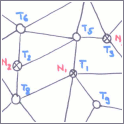Enhanced Situation Awareness

How can we infer the health status of a spacecraft and the variation of its physical properties from the readings of few, strategically placed, sensors?
The Advanced Concepts Team is assessing a novel approach to infer the health s tatus of the spacecraft and its instrumentations from the readings of few, strategically placed thermal sensors [1].
As a starting point the thermal network model of a spacecraft is used. Different nodes with different temperatures define parts of the spacecraft, the interaction between the nodes (the links) is defined by the laws of thermodynamics. Heat transfer either can be convection or radiation. This defines a complex network and we have to decide which nodes should be chosen in order that the network becomes observable, which is equivalent to put thermal sensors on-board of the spacecraft. This choice is neither unique nor does there exist a closed formula to obtain an optimal choice.
System and sensor uncertainties are taken into account in the lumped parameter network (LPN) modeling of the thermal system and a nonlinear dual filter is run on the resulting stochastic model. In the dual filtering configuration [1] the states and the parameters of a dynamic system are estimated simultaneously in an alternating optimization fashion. To cope with the strong nonlinearities of the resulting thermal network we propose to use the "unscented" extension of the well known Kalman filter [2, 3]. The main advantage of the dual filtering based method applied to the thermal network is the possibility of detecting variations in the thermal properties of the spacecraft as a result of variations of its physical properties together with a complete thermal mapping of the system. Events such as faults can be detected by the dual filter as well as new values of system parameters (e.g. radiative couplings) that result from a variation of the spacecraft geometry (e.g. from the deployment of antennas, solar panels, etc.). Finally, the system could be employed as a virtual sensor able to identify anomalous behaviors of a possible faulty physical sensor.
The method proposed is particular attractive in those network whose state and parameters can be estimated by the filter using a minimal amount of readings. The relation between the network topology and this minimal number is therefore an issue strictly related to the observability of the system which is here approached using graph theory.
References
- A. Nelson, Nonlinear estimation and modeling of noisy time-series by dual Kalman filtering methods, Ph.D. thesis, Oregon Graduate Institute, 2000.
- S. Julier, J. Uhlmann, and H. Durrant-White, A new method for nonlinear transformation of means and covariances in filters and estimators, IEEE Transactions on Automatic Control , Vol. 45, 2000, pp. 477–482.
- E. Wan, and R. van der Merwe, The unscented Kalman filter for nonlinear estimation, Proceedings of the IEEE Symposium on Adaptive Systems for Signal Processing, Communication and Control , 2000, pp. 153-158.